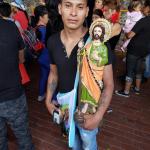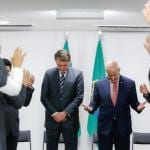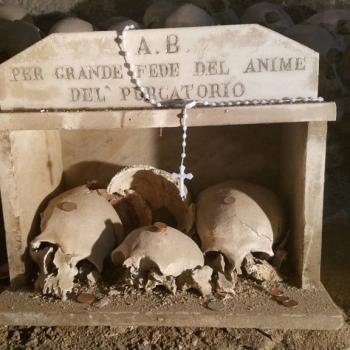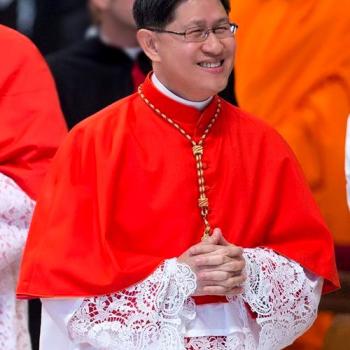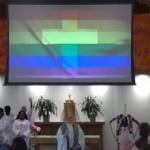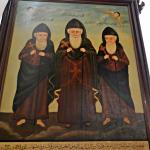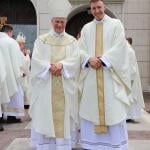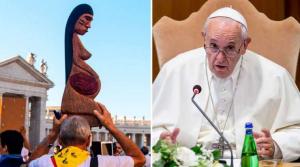
Pachamama has become the latest lightning rod of division in the Catholic Church. She is an Andean fertility goddess representing Mother Earth, venerated primarily by Quechua and Aymara-speaking groups in Bolivia, Peru, and Ecuador. During the recent Synod on the Amazon several statuettes of a naked pregnant woman which first appeared at an Indigenous prayer service held at the Vatican with Pope Francis in attendance became known as Pachamama. The Argentine pope himself referred to the fertility figurines employing the Quechua name even though it’s not clear that the Amazonian artist who sculpted them had the Andean goddess in mind. After their debut at the garden prayer service the statuettes were exhibited at the nearby Church of Santa Maria in Traspontina.
Pachamama and some Indigenous representatives from Amazonia were at the Vatican as part of the Synod on the region. One of the main reasons for the new pastoral focus on Amazonia are the region’s vulnerable Indigenous groups, though it must be pointed out that most inhabitants of the world’s largest rain forest are not Indigenous. Only about 3 million of the vast region’s 34 million inhabitants are Indigenous who belong to some 400 different ethnic groups. However, of the diverse demographics that constitute the population of Latin America, it’s the 8% who are Indigenous that have abandoned Catholicism more than any other demographic.
For example, Guatemala, where at least half of the population belongs to one of the 22 Mayan language groups, has the largest relative Protestant population, the great majority Pentecostal, in Latin America. Today there are far more Mayan Pentecostal pastors than Indigenous Catholic priests. In neighboring Mexico the least Catholic and most Protestant state is uncoincidentally the most Indigenous – Chiapas. If the Mexica saint, Juan Diego who received visions of the Virgin of Guadalupe, was recently canonized despite a lack of historical evidence of his existence it’s because the Vatican is keenly cognizant of Indigenous defection from the Church.
So Indigenous defection to Pentecostalism was one of the chief concerns at the Amazon Synod. New polling data from Brazil reveals that the Amazonian region of the country is now more Protestant, the great majority Pentecostal, than Catholic at 46% to 45%. And in terms of clergy serving in the vast region, Pentecostal preachers far outnumber Catholic priests. Pentecostal pastors can marry and have families and aren’t required to have the equivalent of a master’s degree as are Catholic clergy.
Led by theological liberals, the Synod proposed Evangelization of Indigenous peoples not through colonial and patriarchal perspectives seeking to impose Catholicism in its Western cultural context but rather through acculturation or adapting the essence of the faith to the diverse Indigenous cultures of Amazonia. The Synod working document states, “Listening to the voice of the Spirit in the cry of the Amazon peoples and in the magisterium of Pope Francis requires a process of pastoral and missionary conversion.” Of course acculturation in some form or another has been practiced by the Church for centuries. If Christmas trees, Easter eggs, and even certain saints have been integrated into ritual life it’s because Catholicism incorporated European pagan elements as it spread across the Continent.
In stark contrast, the Pachamama figurines and prayer service at the Vatican led the most reactionary traditionalist and conservative Catholics to denounce them as demonic symbols of pagan idolatry while more moderate elements rejected them as expressions of an uncritical acceptance of all aspects of Indigenous cultures, without the requisite “purification” of Catholicism’s encounter with cultures that are not Christian. In late October two men stole the statuettes from the Church of Traspontina and hurled them into the Tiber River. One of the zealots, an Austrian named Alexander Tschugguel, insisted that he acted to defend the Church from “Satanism.”
Eventually Italian police retrieved the Pachamamas intact from the bottom of the Tiber and returned to them to the Vatican. And the young Austrian zealot who committed one sin, theft (of the statuettes), to right another, idolatry, has become the darling of traditionalist Catholics. He has launched what he calls the St. Boniface Institute with the stated mission to “rally those who do not want to bow down to ‘Mother Earth.”
Impressed by his audacity in resisting “paganism” at the Vatican, traditionalist Catholic groups and individuals such as Tradition, Family, and Property (TFP), LifeSite News, and Taylor Marshall sponsored and organized Tschugguel’s recent speaking tour in the US. Speaking in Virginia, he stated “We do not want to do things out of pure emotion.” He continued, “We also have to think of things. Our faith is intelligent and logical.” Tschugguel also applauded Trump’s decision to withdraw the US from the Paris Climate Accords as an act of “true statesmanship” and criticized the focus both the Church and international institutions have put on Amazonia, even questioning the origin of the conflagrations that engulfed the world’s largest rainforest last summer.
In short, the heated controversy over Pachamama reflects the major divisions in the Church which have been thrown into high relief during the papacy of the first New World pontiff. Those Catholics, led by Pope Francis, who embrace Pachamama see her as symbolic of greater concern for Mother Earth and her daughters and sons who have lovingly tended the maternal garden and in harmony with the Argentine pontiff’s environmentalism. Those who prefer to see Pachamama at the bottom of the Tiber cling to antiquated Eurocentric views that confuse and conflate the faith with European culture. The future of the Church lies in the Global South, especially Africa, so in the not too distant future we shall see whether embracing or obliterating Pachamama is the best way to evangelize non-Christian cultures.


